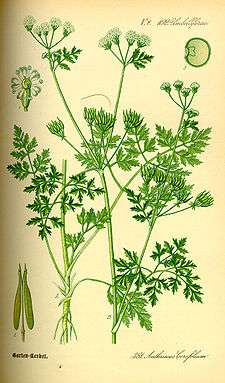Chervil
| Garden Chervil | |
|---|---|
 | |
| Scientific classification | |
| Kingdom: | Plantae |
| (unranked): | Angiosperms |
| (unranked): | Eudicots |
| (unranked): | Asterids |
| Order: | Apiales |
| Family: | Apiaceae |
| Genus: | Anthriscus |
| Species: | A. cerefolium |
| Binomial name | |
| Anthriscus cerefolium (L.) Hoffm. | |
Chervil (/ˈtʃɜːrˌvɪl/; Anthriscus cerefolium), sometimes called garden chervil to distinguish it from similar plants also called chervil, or French parsley, is a delicate annual herb related to parsley. It is commonly used to season mild-flavoured dishes and is a constituent of the French herb mixture fines herbes.
Biology
A member of the Apiaceae, chervil is native to the Caucasus but was spread by the Romans through most of Europe, where it is now naturalised.[1]
The plants grow to 40–70 cm (16–28 in), with tripinnate leaves that may be curly. The small white flowers form small umbels, 2.54–5 cm (1.00–1.97 in) across. The fruit is about 1 cm long, oblong-ovoid with a slender, ridged beak.[1]
Uses and impact
Culinary arts
Chervil is used, particularly in France, to season poultry, seafood, young spring vegetables (such as carrots), soups, and sauces. More delicate than parsley, it has a faint taste of liquorice or aniseed.[2]
Chervil is one of the four traditional French fines herbes, along with tarragon, chives, and parsley, which are essential to French cooking.[3] Unlike the more pungent, robust herbs, thyme, rosemary, etc., which can take prolonged cooking, the fines herbes are added at the last minute, to salads, omelettes, and soups.
Horticulture
According to some, slugs are attracted to chervil and the plant is sometimes used to bait them.[4]
Health
Chervil has had various uses in folk medicine. It was claimed to be useful as a digestive aid, for lowering high blood pressure, and, infused with vinegar, for curing hiccups.[5] Besides its digestive properties, it is used as a mild stimulant.[2]
Chervil has also been implicated in "strimmer dermatitis", or phytophotodermatitis, due to spray from weed trimmers and other forms of contact. Other plants in the family Apiaceae can have similar effects.[6]
Cultivation
Transplanting chervil can be difficult, due to the long taproot.[5] It prefers a cool and moist location; otherwise, it rapidly goes to seed (also known as bolting).[5] It is usually grown as a cool-season crop, like lettuce, and should be planted in early spring and late fall or in a winter greenhouse. Regular harvesting of leaves also helps to prevent bolting.[5] If plants bolt despite precautions, the plant can be periodically re-sown throughout the growing season, thus producing fresh plants as older plants bolt and go out of production.
Chervil grows to a height of 12 to 24 inches (300 to 610 mm), and a width of 6 to 12 inches (150 to 300 mm).[5]
See also
References
- 1 2 Vaughan, J.G.; Geissler, C.A. (1997). The New Oxford Book of Food Plants. Oxford University Press.
- 1 2 Gualtiero Simonetti (1990). Stanley Schuler, ed. Simon & Schuster's Guide to Herbs and Spices. Simon & Schuster, Inc. ISBN 0-671-73489-X.
- ↑ Julia Child, Mastering the Art of French Cooking vol. I p 18.
- ↑ Marshall Bradley, Barbara W. Ellis, Deborah L. Martin, "Chervil is irresistible to slugs" in The Organic Gardener's Handbook of Natural Pest and Disease, Page 363.
- 1 2 3 4 5 McGee, Rose Marie Nichols; Stuckey, Maggie (2002). The Bountiful Container. Workman Publishing.
- ↑ Drugge, Rhett; Dunn, Heather. "Botanical Dermatology Phytophotodermatitis". Electronic Textbook of Dermatology. The Internet Dermatology Society, Inc. Retrieved 12 March 2012.
Further reading
- Howard, Michael. Traditional Folk Remedies (Century, 1987), p. 118.